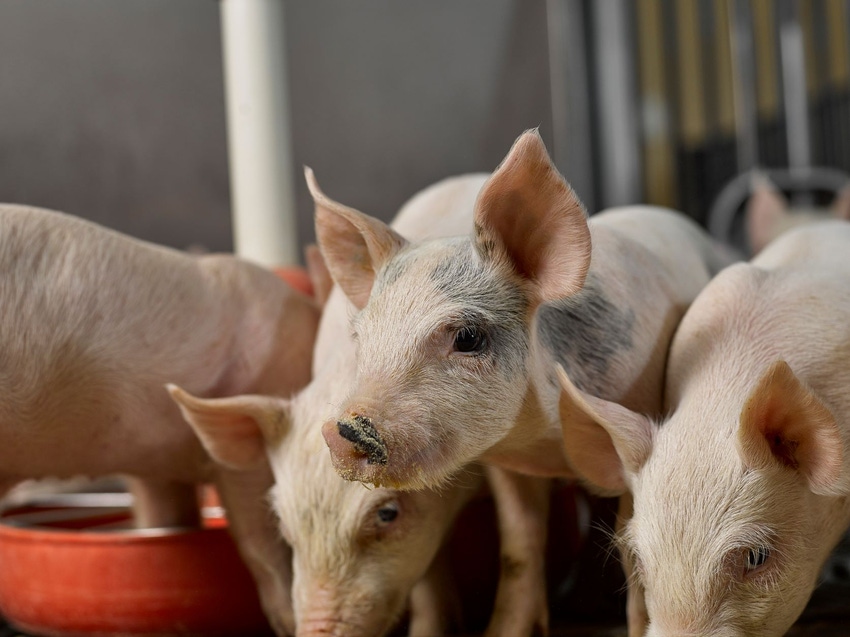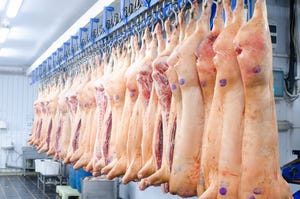High folic acid levels reduce nursery pig growth performance
Folic acid is routinely added to gestation and lactation diets to increase litter size, but its addition to nursery diets is not as common.
November 9, 2023

By Larissa Becker, Mike Tokach, Jason Woodworth, Robert Goodband, Joel DeRouchey and Jordan Gebhardt, Kansas State University
Folic acid is a form of the water-soluble vitamin, B9, and plays an important role in growth, health and maintenance of animal metabolism. Specifically, folic acid plays a crucial role in protein deposition and tissue synthesis. Folic acid is routinely added to gestation and lactation diets to increase litter size, but its addition to nursery diets is not as common.
However, rapidly growing tissues or cells with a high turnover rate are sensitive to folic acid levels, potentially suggesting an increased demand to support growth of young animals. Recently, Wang et al. (2021) conducted research with folic acid levels of 0, 3, 9 or 18 ppm and observed that when folic acid was supplemented to antibiotic free diets, average daily gain increased linearly (P = 0.018).
The folic acid estimated requirement by the NRC (2012) for nursery pigs is 0.30 ppm. In a recent U.S. industry survey, Faccin et al. (2023) reported that the added folic acid levels were 3.80, 2.11 and 1.22 ppm for pigs from weaning to 15 pounds, 15 to 25 lb and 25 to 50 lb, respectively.
Our objective of these two studies were to determine the effects of including folic acid in nursery pig diets on growth performance and serum homocysteine.
Materials and methods
In Exp. 1, 360 barrows (DNA 600 × 241; initially 12.1 ± 0.07 lb) were used in a 38-day growth study to evaluate the effects of including folic acid (Rovimix Folic Acid, DSM, Parsippany, New Jersey) with or without pharmacological levels of zinc oxide on growth performance and fecal characteristics in nursery pigs. Diets did not contain any antibiotics. Pigs were weaned at approximately 19 d of age and randomly allotted to one of six dietary treatments. A total of 72 pens were used with five pigs per pen and 12 replications per treatment.
Dietary treatments were arranged in a 3 × 2 factorial with main effects of folic acid (0, 20 or 40 ppm) and Zn provided by ZnO (3,000 ppm of Zn in phase 1, 2,000 ppm in phase 2, or no additional Zn above that provided in the trace mineral premix). Experimental diets were corn-soybean meal-based and fed in two phases. A common phase 3 diet was fed to all pigs. All diets contained 110 ppm of Zn provided by the trace mineral premix, but the premixes did not contain folic acid. Pigs were weighed on d 0, 9, 17, 24, 31 and 38 to determine ADG, average daily feed intake and feed efficiency.
For Exp. 2, 350 barrows (DNA 200 × 400; initially 13.2 ± 0.12 lb) were used in a 38-d growth trial. Pigs were weaned at approximately 21 d of age and randomly allotted to one of five dietary treatments in a completely randomized design. A total of 70 pens were used with five pigs per pen and 14 replications per treatment.
Dietary treatments were corn-soybean meal-based and consisted of increasing added folic acid: 0, 5, 10, 20 or 40 ppm (Rovimix Folic Acid, DSM, Parsippany, NJ; Table 1). The vitamin premix utilized in these diets did not contain folic acid. Treatment diets were fed in three phases from d 0 to 10 (phase 1), d 10 to 23 (phase 2) and d 23 to 38 (phase 3) after weaning. Pigs were weighed on d 0, 10, 17, 23, 31 and 38 to determine ADG, ADFI, and feed efficiency.
On d 10 and 23, one average weight barrow from each pen (14 per treatment) was bled for analysis of serum homocysteine concentration. Blood was collected in tubes without anticoagulant to obtain serum. The blood was allowed to clot before centrifuging for 15 minutes at 1,500 × g to collect serum, and samples were stored at 0°F (-18°C) until analyzed. Samples were analyzed in duplicate within a single assay. Serum concentrations were determined using ELISA kits per the instructions of the manufacturer (Aspira Chemical, Oakland, California).
Exp. 1 Results
For growth performance responses, no folic acid × pharmacological levels of Zn interactions were observed (P > 0.10) throughout the study.
Overall (d 0 to 38), there was a quadratic (P ≤ 0.003) response in final body weight, ADG and ADFI when pigs were fed folic acid in phase 1 and 2 diets with pigs fed 20 ppm having the poorest performance. No differences (P > 0.10) were observed when pigs were fed diets with or without pharmacological levels of Zn in phases 1 and 2. Additionally, no statistical differences (P > 0.10) were observed in mortality across all dietary treatments. However, numerical differences were observed. Pigs fed no added folic acid had 0% mortality, compared to pigs fed 20 or 40 ppm that had 7.5% or 10% mortality, regardless of Zn addition.
KSU
Exp. 2 Results
Overall (d 0 to 38), there was a significant response observed for final BW, ADG, ADFI and feed to gain ratio where performance decreased as folic acid increased in the diet, with pigs fed 20 ppm having the poorest performance (quadratic, P ≤ 0.047).
For blood homocysteine concentration, a marginally significant linear treatment x day interaction was observed (P = 0.069) as folic acid increased across treatments. An increase (linear, P = 0.037) in homocysteine concentration was observed as folic acid increased from 0 to 40 ppm in the diet on d 10. However, no differences were observed across increasing levels of folic acid on d 23 (P = 0.450). Pigs had increased (P < 0.001) homocysteine concentrations on d 10 compared to d 23.
KSU
An increase in serum homocysteine concentrations indicates that the treatment diets with added folic acid downregulated the enzyme MTHFR. This enzyme is responsible for converting folic acid into the active form in order to serve as a methyl donor needed for the conversion of homocysteine to methionine.
In conclusion, the addition of folic acid resulted in reduced growth performance in both studies with the greatest impact observed when pigs were fed 20 ppm. This data suggests that the basal diets contain adequate folic acid and that added folic acid is not necessary in nursery diets.
This data along with additional information research will be discussed more in-depth at the 2023 K-State Swine Industry Day on Nov. 16.
You May Also Like
.png?width=300&auto=webp&quality=80&disable=upscale)


